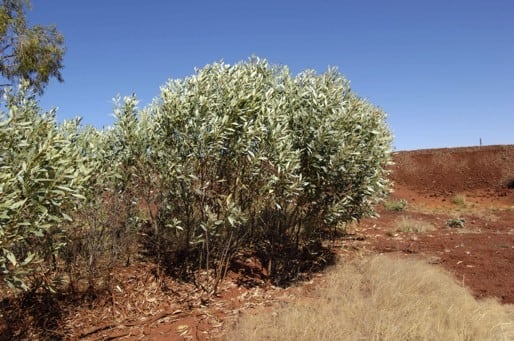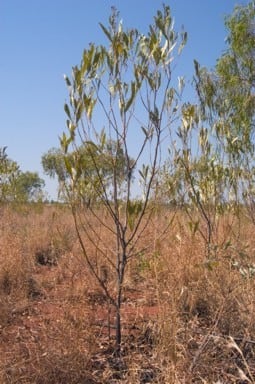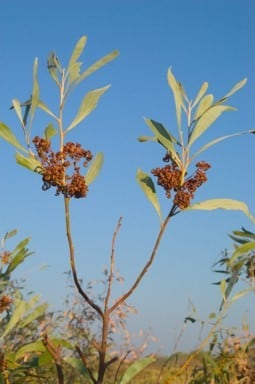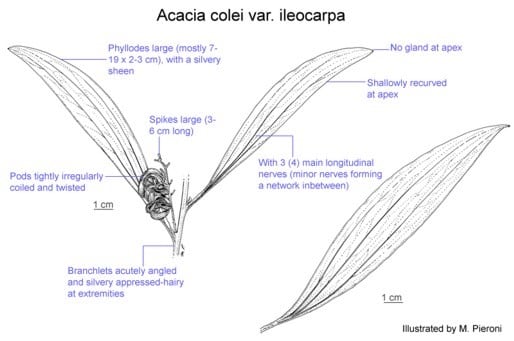Acacia colei var. ileocarpa M.W.McDonald & Maslin
WATTLE
Acacias of Australia
Common Name
Curly-pod Kalkardi
Family
Fabaceae
Distribution
Scattered distribution in the southern Kimberley region of W.A. and adjacent parts of western N.T.; also has a restricted distribution in the Pilbara region of W.A.
Description
Terminal branchlets often orange-coloured. Phyllodes 10–25 (–40) mm wide. Pods tightly and irregularly coiled or twisted. Seeds 3–3.5 (–4) mm long.
Phenology
Flowers June–July.
Habitat
Occasionally sympatric with var. colei in the Kimberley, e.g. Luluigui Stn (SW of Fitzroy Crossing), and possibly also sometimes in the Pilbara. In the Kimberley it is associated with floodplains and drainage lines and grows on clay loams (pH 5.5–6.5), in open or low open woodlands dominated by various Eucalyptus spp. In the Pilbara it occurs on slightly alkaline sandy loam (pH 7.5–8.5), mostly in open Acacia shrubland.
Specimens
W.A.: between Rober [Robe R.] and Millstream, H.Demarz 7663 (BRI, PERTH); Gibb R. rd, 68.2 km SE of Windjana Gorge turn off, C.E.Harwood & M.McDonald CEH 474 (PERTH); 17 km E of Halls Ck on Duncan Hwy, L.Thomson LXT 1291–1295 (all PERTH). N.T: 7 km SE of Negri River on Duncan Highway, SSE of Kununurra, B.R.Maslin 7120A (PERTH).
Notes
Acacia colei is a hexaploid and appears to have evolved as an allopolyploid from A. neurocarpa (diploid) and A. cowleana (tetraploid), fide G.F.Moran et al., in A.House & C.Harwood (eds), Australian Dry-Zone Acacias for Human Food (1992), and M.W.McDonald & B.R.Maslin, Nuytsia 11: 22 (1997). Acacia colei is closely related to A. holosericea as well as to A. neurocarpa but is most reliably distinguished by its phyllodes which lack a gland at the base of their apical mucro, are shallowly recurved towards their apices (straight in A. holosericea and A. neurocarpa) and have a different nervation pattern as discussed by B.R.Maslin & L.A.J.Thomson, Australian Systematic Botany 5(6): 729–743 (1992). The curved (not coiled) pods of var. colei further distinguishes this variety not only from its two close species relatives, but also from var. ileocarpa. Acacia colei var. colei is frequently sympatric and occasionally hybridises with A. cowleana (e.g. near Elliot, N.T., L.Thomson LXT1226, PERTH) and infrequently sympatric with A. neurocarpa (e.g. Dampier Penin. and near Halls Creek, W.A., Fish R. Gorge, N.T.).
In West Africa, A. colei is used on an increasing scale for windbreaks, land rehabilitation and fuelwood production. Also, the seeds are highly nutritious and have vast potential as a new food crop for dry, sub-Saharan Africa; var. ileocarpa is preferred to var. colei for this purpose, fide A.Rinaudo et al., Conservation Science Western Australia 4: 161–169 (2002) and A.Rinaudo & P.S.Cunningham, Muelleria 26: 79–85 (2006).
Variation for phyllode width and seed size in var. ileocarpa relative to that found in var. colei is discussed in M.W.McDonald & B.R.Maslin, loc. cit.
FOA Reference
Data derived from Flora of Australia Volumes 11A (2001), 11B (2001) and 12 (1998), products of ABRS, ©Commonwealth of Australia
Author
B.R.Maslin
This identification key and fact sheets are available as a mobile application:
URL: https://apps.lucidcentral.org/wattle/
© Copyright 2018. All rights reserved.












